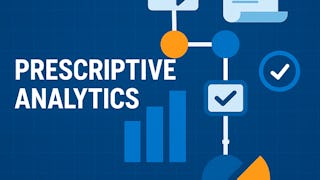In this data-driven world, companies are often interested in knowing what is the "best" course of action, given the data. For example, manufacturers need to decide how many units of a product to produce given the estimated demand and raw material availability? Should they make all the products in-house or buy some from a third-party to meet the demand? Prescriptive Analytics is the branch of analytics that can provide answers to these questions. It is used for prescribing data-based decisions. The most important method in the prescriptive analytics toolbox is optimization. This course will introduce students to the basic principles of linear optimization for decision-making. Using practical examples, this course teaches how to convert a problem scenario into a mathematical model that can be solved to get the best business outcome. We will learn to identify decision variables, objective function, and constraints of a problem, and use them to formulate and solve an optimization problem using Excel solver and spreadsheet.

Gain next-level skills with Coursera Plus for $199 (regularly $399). Save now.

Optimization for Decision Making
This course is part of Analytics for Decision Making Specialization

Instructor: Soumya Sen
8,274 already enrolled
Included with
(89 reviews)
Recommended experience
Skills you'll gain
Details to know

Add to your LinkedIn profile
8 assignments
See how employees at top companies are mastering in-demand skills

Build your subject-matter expertise
- Learn new concepts from industry experts
- Gain a foundational understanding of a subject or tool
- Develop job-relevant skills with hands-on projects
- Earn a shareable career certificate

There are 4 modules in this course
Prescriptive analytics is a part of business analytics that is aimed at prescribing solutions to decision problems. The most important modeling technique within prescriptive analytics is optimization. In this module, we will learn how to recognize contexts where it can be applied and get introduced to the basics of linear optimization.
What's included
11 videos1 reading2 assignments1 discussion prompt
In order to solve linear optimization problems (i.e., linear programs), we can use graphical methods for basic example problems. For higher dimensional problems, we will use tools like Excel Solver later in the course. The benefit of using graphical methods is that it gives us an intuition into how these problems can be solved.
What's included
8 videos2 assignments
In this module we will explore what happens when the model parameters are changed. We will also look at special cases of linear optimization problems.
What's included
7 videos2 assignments
Having learned how to formulate linear optimization problem and the graphical methods for solving them, we are now going to start solving larger problems using Excel Solver. This module provides an overview of how to set up and solve these decision problems using Excel.
What's included
13 videos2 readings2 assignments
Earn a career certificate
Add this credential to your LinkedIn profile, resume, or CV. Share it on social media and in your performance review.
Instructor

Offered by
Explore more from Data Analysis
 Status: Free Trial
Status: Free TrialUniversity of Minnesota
 Status: Free Trial
Status: Free TrialUniversity of California, Irvine
 Status: Preview
Status: PreviewO.P. Jindal Global University
 Status: Free
Status: FreeThe Chinese University of Hong Kong
Why people choose Coursera for their career




Learner reviews
89 reviews
- 5 stars
80.89%
- 4 stars
14.60%
- 3 stars
3.37%
- 2 stars
0%
- 1 star
1.12%
Showing 3 of 89
Reviewed on May 31, 2021
There are a lot of examples to work through and learn from which I find helps make the material easier to learn.
Reviewed on Jan 15, 2024
The professor was easy to follow. I learned more from this course than a whole semester of Optimization in my graduate class.
Reviewed on May 15, 2021
Good teaching style with step by step guidance. Thanks for the connecting high school math (that I learned many years ago) to real life context. I look forward to the next course.

Open new doors with Coursera Plus
Unlimited access to 10,000+ world-class courses, hands-on projects, and job-ready certificate programs - all included in your subscription
Advance your career with an online degree
Earn a degree from world-class universities - 100% online
Join over 3,400 global companies that choose Coursera for Business
Upskill your employees to excel in the digital economy
Frequently asked questions
To access the course materials, assignments and to earn a Certificate, you will need to purchase the Certificate experience when you enroll in a course. You can try a Free Trial instead, or apply for Financial Aid. The course may offer 'Full Course, No Certificate' instead. This option lets you see all course materials, submit required assessments, and get a final grade. This also means that you will not be able to purchase a Certificate experience.
When you enroll in the course, you get access to all of the courses in the Specialization, and you earn a certificate when you complete the work. Your electronic Certificate will be added to your Accomplishments page - from there, you can print your Certificate or add it to your LinkedIn profile.
Yes. In select learning programs, you can apply for financial aid or a scholarship if you can’t afford the enrollment fee. If fin aid or scholarship is available for your learning program selection, you’ll find a link to apply on the description page.
More questions
Financial aid available,

